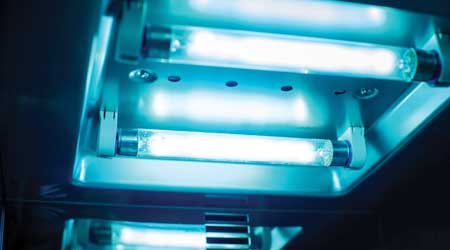Buyer Beware: Practical Tips for Germicidal Lighting Use
Facility managers must be diligent about germicidal lighting to ensure what they're buying is safe and effective against coronavirus.
The germicidal lighting industry operates in what James Malley, professor of civil and environmental engineering at the University of New Hampshire, specializing in UV technology for public health, calls a "regulatory abyss," though there is some oversight from EPA and FDA. Again, the technology is proven and has been manufactured by reputable companies for specific uses in unoccupied space for decades. But in a world responding to a pandemic, there's a fair share of snake oil going around as well. Facility managers must put UVGI technologies through a rigorous due diligence process in order to ensure what they are buying and installing is safe and effective.
To begin with, time is the least important performance parameter, says Malley. "If all they talk about is time, they don't know what they're doing," he says. Space geometry, light intensity delivered, and dose required to deactivate the pathogen are more important parameters to evaluate. Geometry pertains to the object or space that needs to be sanitized. If it's full of nooks and corners, UV-C won't be as effective because light doesn't sneak around corners or behind things. In addition, porous surfaces or fabric surfaces are hard to sanitize with UV-C because the virus can sit in the shadow of a pore or fiber.
UV intensity drops off very quickly with distance, so facility managers need to be aware of how much UV-C is actually being delivered to the surface. This can be accomplished by taking sensor measurements of UV intensity at the surface. There are also UV dosimeters that are kind of like stickers available on the market that can indicate the levels delivered, Malley says.
Facility managers should also ask to see the testing reports the company is using to validate its technology. Look at what distance the device was placed from the pathogen, and try to find out what pathogen it was tested against. One way to cook the data is to have a fixture tested against an easily killed pathogen at a very close distance, allowing the manufacturer to claim high kill rates against germs. Reputable manufacturers will be happy to provide their third-party testing data, Malley says.
Also make sure you have all the components in place for the UV-C technology to be successful. Upper room UVGI applications work well only if there is appropriate air mixing to be able to expose as much of the room's air to the fixture's kill zone as possible.
Lastly, don't expect UV-C lamps to be a one and done solution to solving the COVID-19 pandemic or any other pathogen. "It's a good tool in the tool box, and it's another barrier, but it can't do the job by itself," says Malley. Consider it a final layer of protection, after a robust cleaning protocol, proper maintenance procedures, and personal protection protocols.
Email comments and questions to naomi.millan@tradepress.com.
Related Topics:













